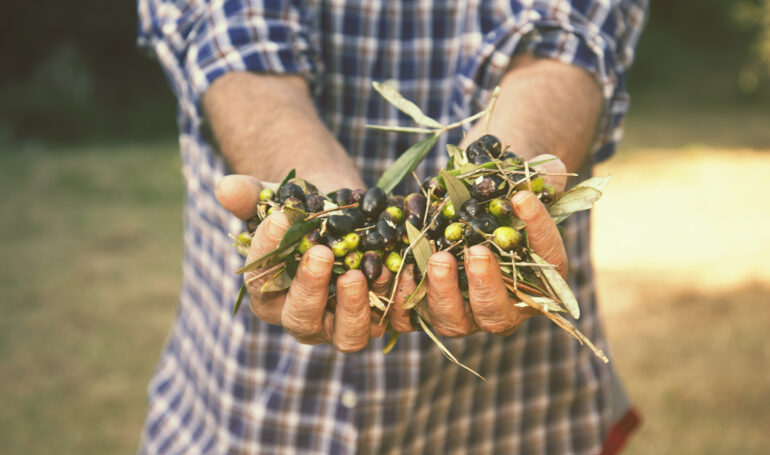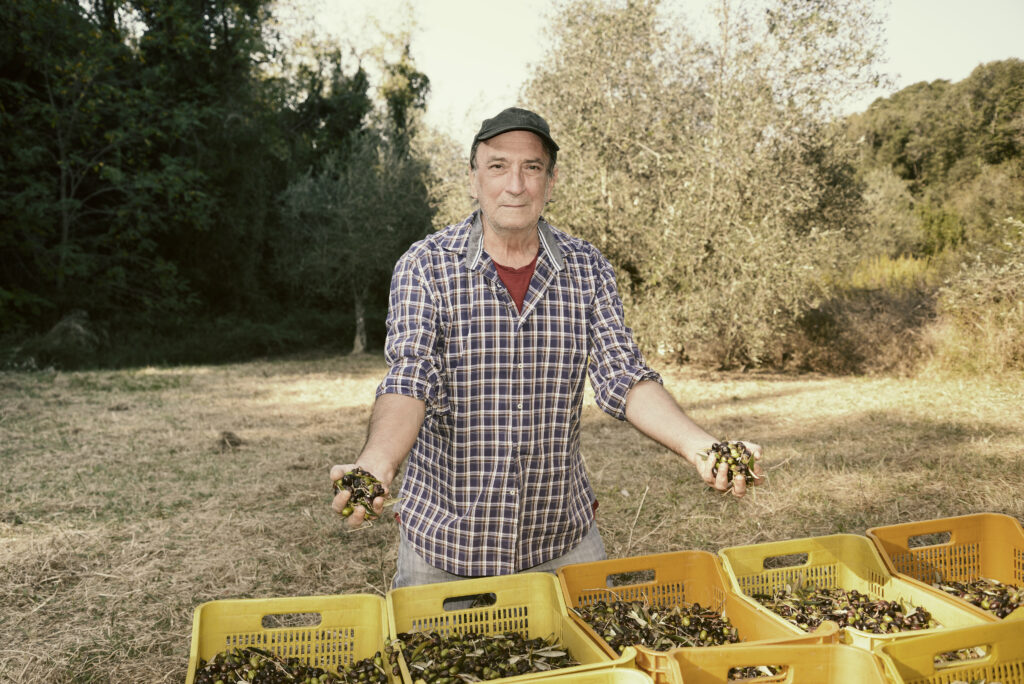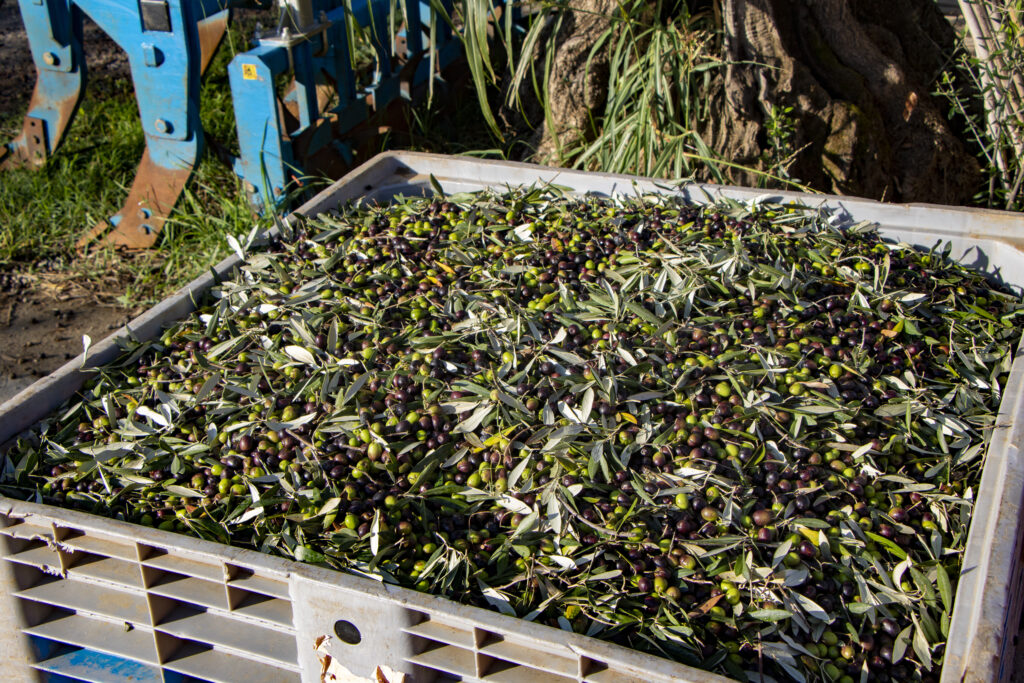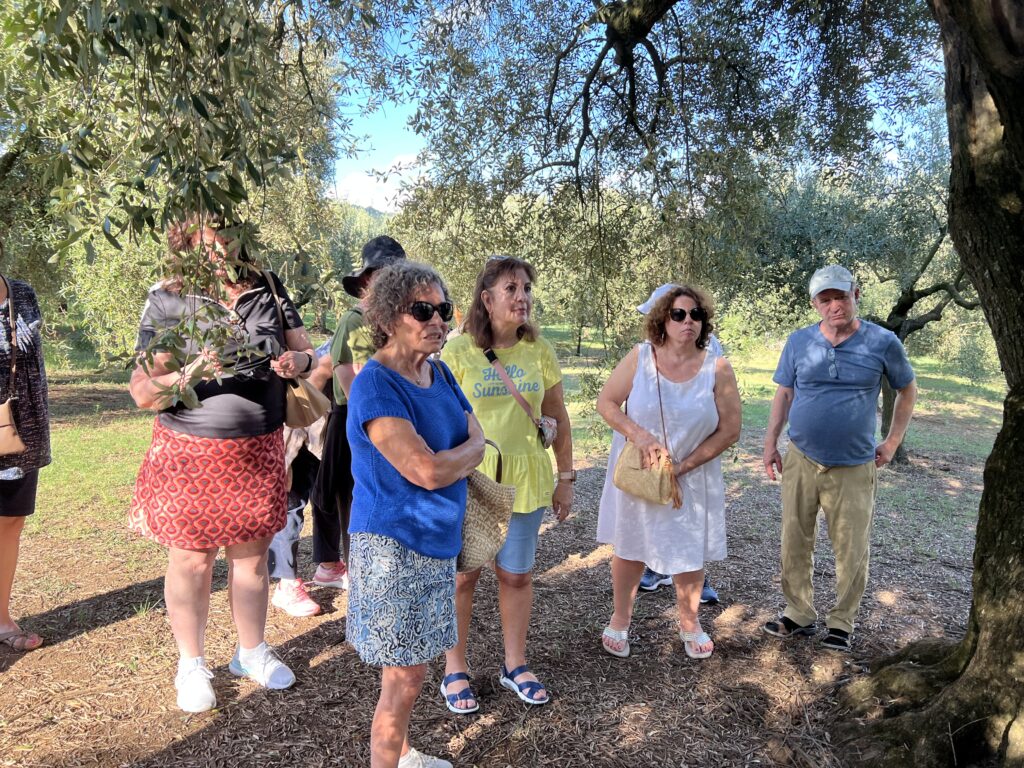
The Seven Phases of Olive Oil Production
Ever wonder about the olive oil production and how olive oil is made? Extra virgin olive oil is a staple in my kitchen. Aside from baking, I can’t think of many dishes I prepare at home that do not require olive oil. It’s a key ingredient in Italian and Mediterranean cooking, and in addition to providing flavor, is also very heart healthy.
I grew up in Italy, and one of my fondest memories is “helping” my family pick olives for our yearly supply of extra virgin olive oil. We had a sizeable plot near our home where our family grew olive trees. This plot of land also contained many fig trees. And since our house didn’t have a backyard, we would use this plot and visit here for picnics and fun times. Times otherwise spent in a typical backyard. This was a wonderful place where us kids could roam around freely and safely. We could certainly burn off some energy. Luckily, it was just a few minutes walk from our home, so it was our backyard away from home.
Our Fascination with EVOO
Our love affair in the US with imported extra virgin olive oil is intense. According to data, in 2022, the United States imported Italian olive oil for a value of over 563 million euros. Our taste buds have become more refined and it shows with the purchases we make.
Now, as a young child, the “help” I actually provided in picking the olives was minimal at best. I recall my mom handing me a large white bucket and telling me to “go and fill it, and don’t come back until it’s full.” Truth be told, I ran around like a wild child more than help! My favorite part was not the manual labor but waiting until mom set the picnic table. A wicker basket of goodies awaited. She would always fill a bountiful basket in the morning for us to enjoy. She would prepare many beautiful dishes to eat during the day. Some dishes included cutlets, baked pasta dishes and various focaccia breads. And let’s not forget the antipasto plates filled with cheeses and salami!
Yes, lunch was definitely my favorite part of my “work day” picking olives! After all, a day in the fields was hard work requiring fuel.
Since it’s fall, and all of Italy is currently preparing for the upcoming olive oil production, I thought it would be appropriate to put together a guide of the seven stages of olive oil production. All the work involved will surely justify the cost of this liquid gold.

Phase 1: Collection
Of course, it all begins with the olive harvest, a critical phase for the production of oil. From the techniques used and the period in which this operation takes place, the taste of the oil and its quality depend on it. For a good harvest, it is advisable to wait for the color of the fruit to change from green to black. This is, in fact, the phase in which there is a greater quantity of oil in the fruit, and greater nutrients that lead the final product to have superior quality and taste. The collection has two methods: manual and mechanical.
Manual
Bacchiatura consists of “beating” the branches of the olive tree with sticks to make the olives fall and then collecting them with nets placed on the ground. This was mostly the method we used when I lived in Italy, because the mechanical method requires expensive tools that my family didn’t find the need for.
Brucature instead consists of picking the olives by hand directly from the branches. It has the advantage of not damaging the olives and is suitable for producing top-quality oils as all the fruits are selected by hand individually. I would also use this method in Italy, much to the dismay of my mother, who was sure I’d fall from a tree and break my neck. (I can almost hear her now screaming at me to get down!)
Mechanics
In shaking, the olives are harvested thanks to mechanical arms that wrap around the trunk or branches of the tree that are lightly beaten with a result of the fruit falling to the ground.
In combing instead, the branches are “combed” by special tools that detach the olives from the trees. The nets attached to the trees underneath catch the fallen olives.
Phase 2: Storage
The storage phase of processing of the olives should not be underestimated. If the olives remain on the branches for too long or are left on the ground, they can undergo a maceration process, disrupting the oil production. To not compromise the quality of the olives, one should take them to the mill within 48 hours of harvesting. A lot of attention must also be paid to the type of container used for storage. The olives must be stored in special ventilated boxes in plastic and then stored away from heat sources. This guarantees that the olives do not ferment.
Phase 3: Defoliation and Washing
Before being introduced into the actual processing cycle, the olives must undergo a defoliation and a washing process, both for hygienic and sanitary reasons and for qualitative reasons of the oil. Furthermore, removing the material often accompanying the olives is particularly appropriate when the oil mill adopts the metal crusher to prepare the olive paste and the centrifugal decanter for oil separation. The presence of leaves could affect the characteristics of the oil.

Phase 4: The Pressing of the Olives
In the milling process, the harvested olives, after being cleaned and washed, are subjected to mechanical actions in the mill to cause the cell wall and membranes that compose them to break. In this way, the oil comes out of the fruit, allowing for the oil collection. The breaking is carried out naturally by rubbing the stones against the ends of the fruit. In this way, a “raw” olive oil is extracted, also called oil paste, a semi-fluid compound that is the main product of the pressing of the olives.
Phase 5: Kneading
Kneading is the process that follows the milling or pressing, and has the purpose of breaking the emulsion between water and oil. This allows for the oil to flow into more significant drops that tend to separate from the water spontaneously.
This phase determines the relationship between quantitative yield and oil quality. Heating will increase the effectiveness of the kneading, allowing the increase of the oil yield, however, it will negatively affect the quality.

Phase 6: The Extraction of the Oil
Extraction is the process that finally sees the appearance of a product close to the one we know as olive oil. There are different techniques to bring this phase of olive oil production to completion:
- Pressure (classic and discontinuous method)
- Centrifugation (modern and continuous method)
- Percolation by selective filtration
Pressure
A series of well-defined phases characterize extraction by pressure. A pressing shield is applied that separates the liquid portion from the pomace. The resulting fluid must then be centrifuged (centrifugation) first to separate the water from the oil. The compound obtained is then filtrated, resulting in virgin olive oil.
Centrifugation
With centrifugation, on the other hand, all the final components are obtained simultaneously with a single and continuous process.
Percolation
In percolation, a large sheet of steel is immersed in the malaxer machine, which, thanks to the difference in surface tension between the two fluids, gets wet mainly with oil, causing the water to be drained into another container.
Phase 7: Storage and Bottling of the Oil
Storage
At this point, the product obtained is ready for consumption. However, it still contains solid residues and is muddy to the eye. Therefore, it must be stored in stainless steel tanks, following chemical tests. Its optimum storage temperature is 15° -17° C without sunlight.
Bottling
Bottling is one of the most delicate phases of the final part of oil production because it is necessary to limit contact with the air during the transfer. Packaging is carried out by specific equipment that allows the oil to be poured into suitable containers.
The oil is then bottled and sealed, avoiding altering its properties. The containers must be made of dark glass to avoid contact with light, or alternatively, special tinplate containers can be used, previously treated with antioxidant materials.
For Your Kitchen
In the US, we have a wealth of options when selecting imported extra virgin olive oil from Italy. But be a weary consumer. Olive oil production isn’t very well regulated in the US, meaning olives from anywhere in the world can be shipped to Italy, bottled, and have a “Made in Italy” label slapped on. Look instead for oil that is sourced and bottled in the same area. Look for a harvest date on the bottle, as well as a point of production. Also, producing real extra virgin olive oil is an expensive and labor-intensive process, so expect to pay a hefty price. If something is cheap, chances are, you are getting an imposter.
Extra virgin olive oil should be used at a maximum of two years from bottling. Some trusted Italian brands you can find in the US include Monini, Manni or click here to visit the Olive Oil Lovers website to view and select a bounty of truly authentic Italian olive oils. If you’re looking to buy some directly from one of our preferred vendor in Tuscany, visit Sagittario Impruneta by clicking here. You can now purchase for their current harvest, for December delivery. Tell them I sent you!
If you’re looking for a high quality US-made, budget friendlier oil, select California Olive Branch brand.
Leave a Reply

What to Pack for Italy
Cosa Mettere in Valigia per l'Italia
Everyone is always asking me what they should pack for Italy,
so I’ve created a quick reference guide that you can use for your next trip.
Hint: You don’t need nearly as much as you think you do!

2 Comments
This was amazing!! Please add me to the list for the newsletter
Thanks so much Theresa! I thought you already were, but I have just added you! I hope you’re doing wonderfully! xo